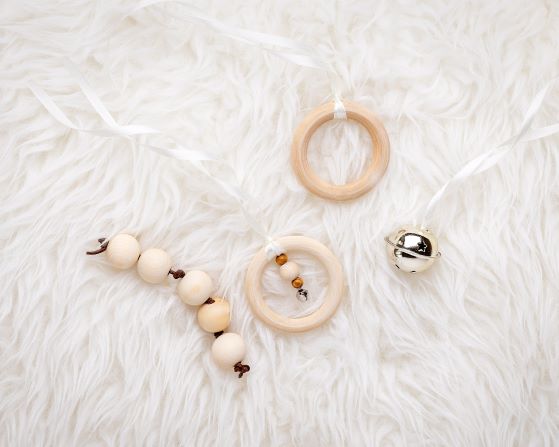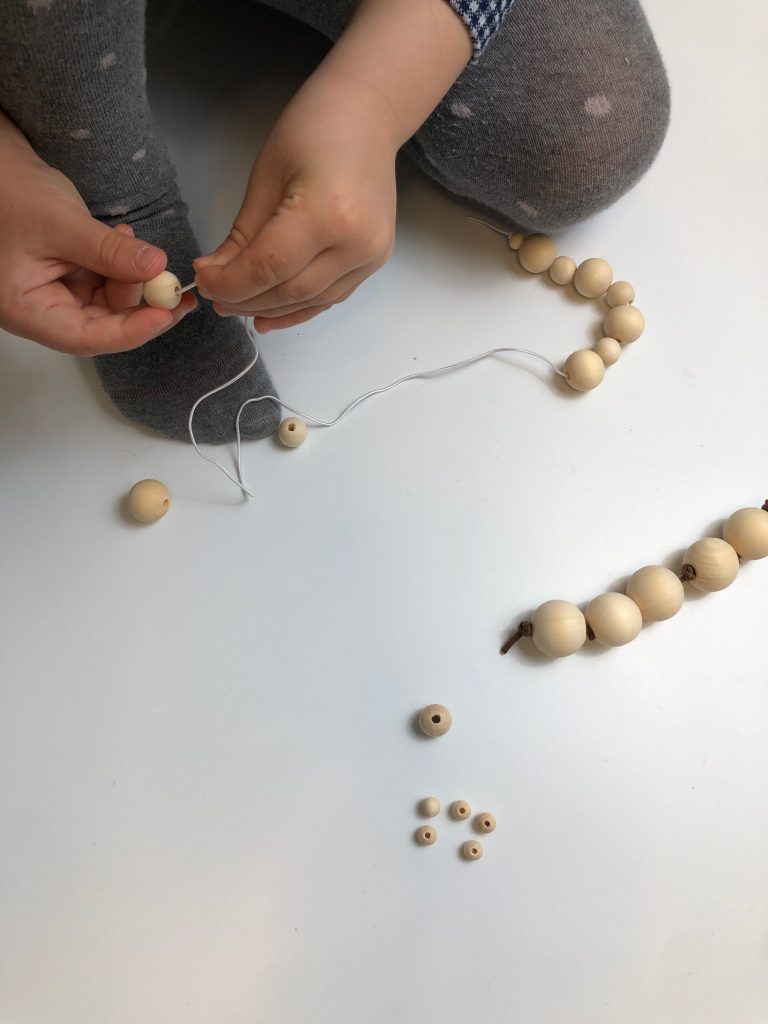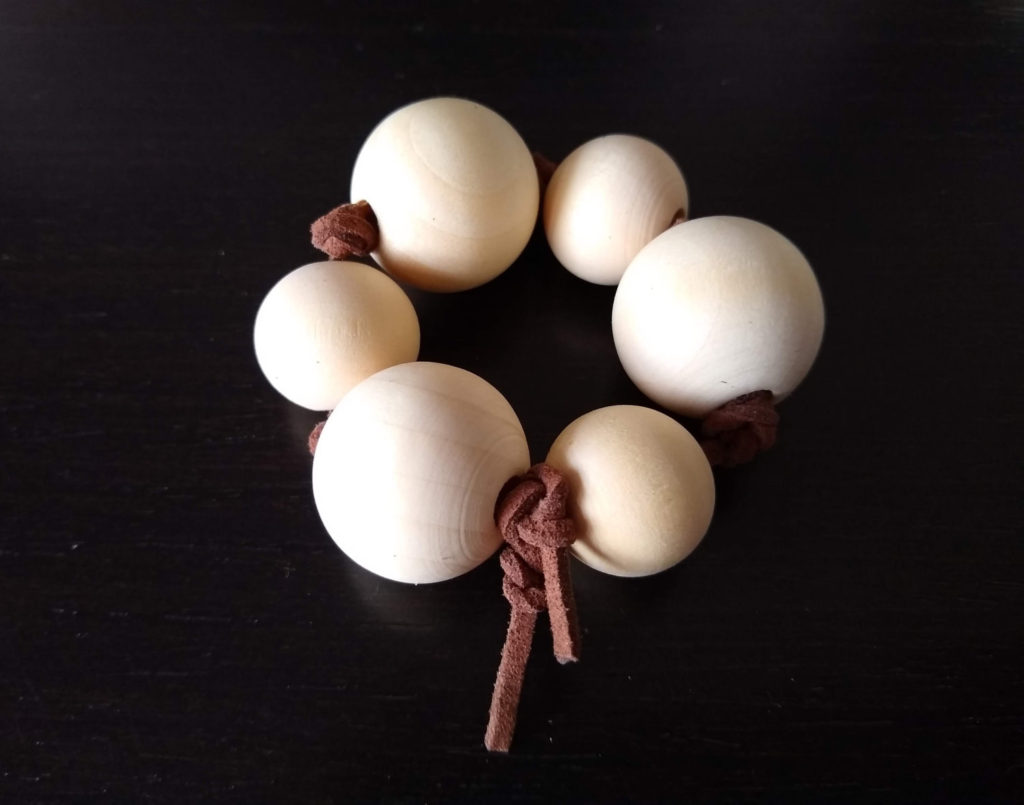ANOTHER Montessori Tactile Mobile? Well, this is not technically a baby mobile, as it is not for hanging. When babies hit the approximate age of about 2.5-3 months, their interest moves from reaching, batting, catching, pulling to the world of grasping. Another – very often overlooked – huge milestone in your little one’s life! (They grow so fast, don’t they? sniff) But how do you know whether your baby is ready for this step? Read on to learn the signs and how the Montessori Grasping Beads help during the next phase of development.
WHAT’S THE AIM OF THIS TACTILE MOBILE?
Observe the muscles in the hands. Are they fully controlled or they need some extra attention? A great sign of this is when a baby grabs something but it somehow, inexplicably falls out of those tiny hands. And the baby just looks on, not really understanding what has just happened. Or, when he manages to grab onto something but cannot for the life of him figure out how to let it go!
This is the moment when the Montessori Grasping Beads come in (cue superhero music). The secret is all in the name: their design enables your baby to learn to grasp, hold and to manipulate in a variety of ways using the sense of touch. Read on to find out more!
WHAT DOES IT LOOK LIKE?
The traditional Montessori Grasping Beads are made up of (usually) five large natural, wooden (if possible, raw wood) beads, although I have seen them made with more or less beads, too. These are strung on a bit of rope made of something natural, such as a piece of leather or organic hemp.
As with all the previous mobiles, this one’s job is also to single out and stimulate one sense, this time it’s touch. Another Montessori principle is that it’s all made of natural resources and the end result is a lovely-looking object that even an adult’s fingers are itching to touch.

part of the DIY Full Tactile Set, available in my Shop
SO WHY ARE THE MONTESSORI GRASPING BEADS SO ATTRACTIVE FOR YOUR BABY?
It’s all good and fun making the Bell on a Ribbon jingle or pulling the Ring on a Ribbon, but what if an interesting object needs a closer examination which doesn’t bounce away once your little one lets it go? These beads are perfect for getting those little muscles learning how to grab on to something. They are so smooth and interesting to touch, it’s a whole new tactile experience! The colour of the beads is a natural colour that’s not too bright for your baby’s eyes so s/he can really focus on the feeling in the hands and fingers.
As I mentioned before, traditionally there are five large beads strung on a rope. The alternation of the bead/rope/bead/rope sequence serves as a point of interest, something that needs closer and longer inspection.
Being able to grasp a desired object has a huge impact on a baby’s understanding of the world. Those babies who use their hands a lot to explore a variety of items have a greater understanding of their place in their surroundings. This means that they feel more confident in themselves and have greater motivation to discover. After being able to grab, hold and let go, babies will explore other movements as well, such as passing it from one hand to another, holding it with two hands or throwing and crawling after them.

WHAT ARE THE SCIENTIFIC BENEFITS?
- They strengthen hand muscles
- Assist in making controlled, voluntary movements in the hands
- Stimulate fine and gross motor skills
- Provide new sensory experiences
- Encourage coordination of fingers
- Make purposeful movements and planned actions
- Develop hand-eye coordination
- Open their curiosity towards their surroundings
- They practice transferring an object from one hand to another
- When they take the Beads from one hand to another, they cross the midline of the body…
- …Which in turn stimulates both sides of the brain
TIPS AND TRICKS
After your baby is familiar with the original design, why not make it more fun? We can alternate the size of the beads often so the sensation that the brain receives while exploring can vary. This change in size can prolong the use of the Beads as well as help sensory development.
Tummy time is a great opportunity to explore this Montessori material in a different way. This will help to build up those chest and arm muscles and prepare the upper body for crawling.
This material is NOT a mouthing toy, they are only meant to be practiced holding and grabbing. Even though the beads are big, there’s always a danger of swallowing them accidentally. Please ALWAYS supervise your little one when s/he explores this tactile mobile.
However, from around 6 months, if you treat the wood, you can use it as a teething toy. I would personally tie the two ends of the rope together to make a bracelet. You can even use a wooden ring (maybe from the Ring on a Ribbon mobile) to add an extra interest point.

FINAL THOUGHTS
The Montessori Grasping Beads are one of those Montessori sensory materials that take only a minute to make but provides hours of fun to your baby. All of its elements are natural and it’s easy to carry around. And we haven’t even mentioned its developmental benefits! It’s very easy to DIY this tactile mobile. If you have an older child, you probably have some big beads at home. It’s a great gift for the baby from an older sibling or the perfect pregnancy/baby shower gift.
If you’d like to buy it as part of a set, head over to my Shop to get it as part of the DIY Full Tactile Set.
Click here to read more about how the Montessori Visual Mobiles, the Montessori Tactile Mobiles or the Sensory Baby Toys help your baby’s development.
How did your baby react to this mobile? Please share your photos on my Instagram site. #montessoriedited, @montessoriedited
